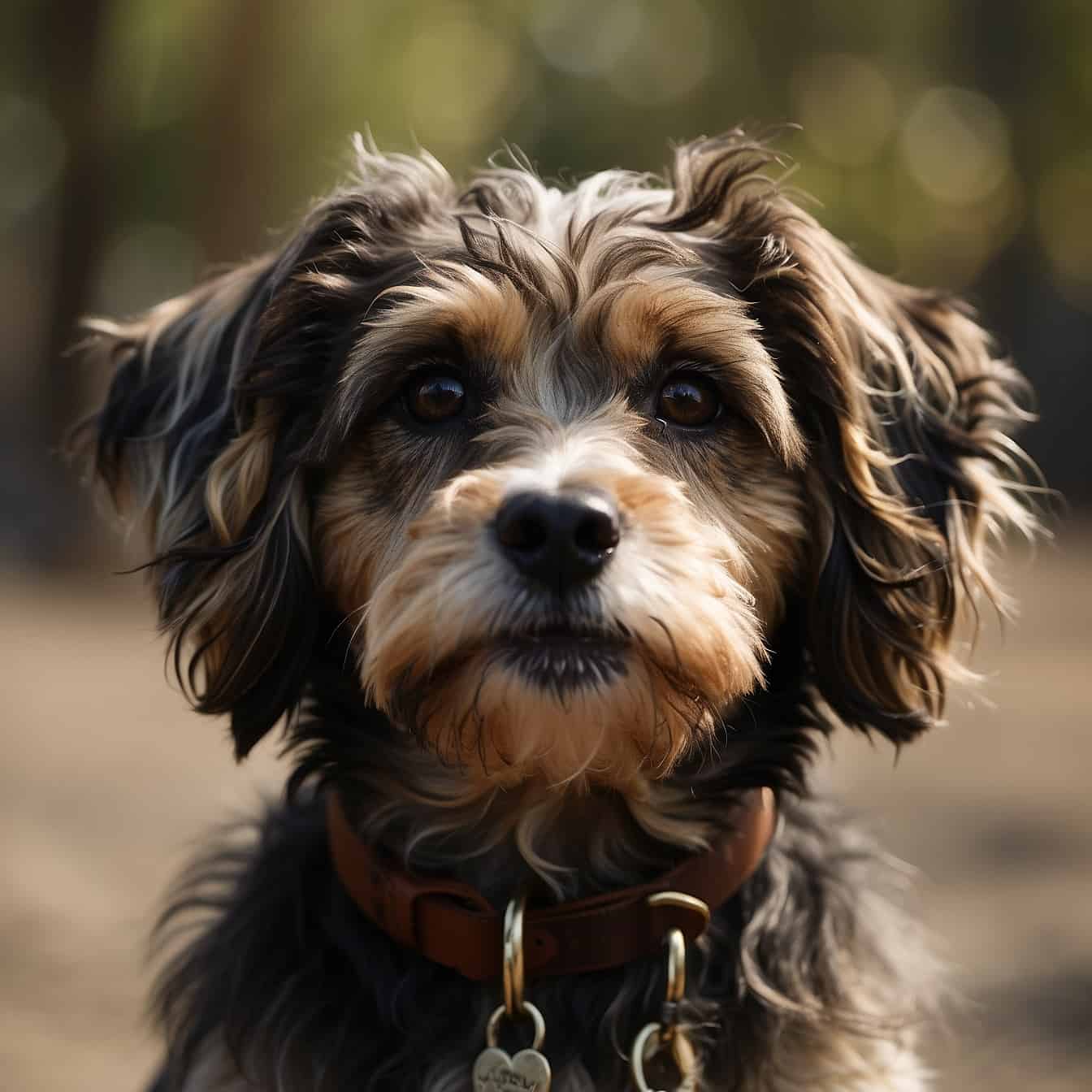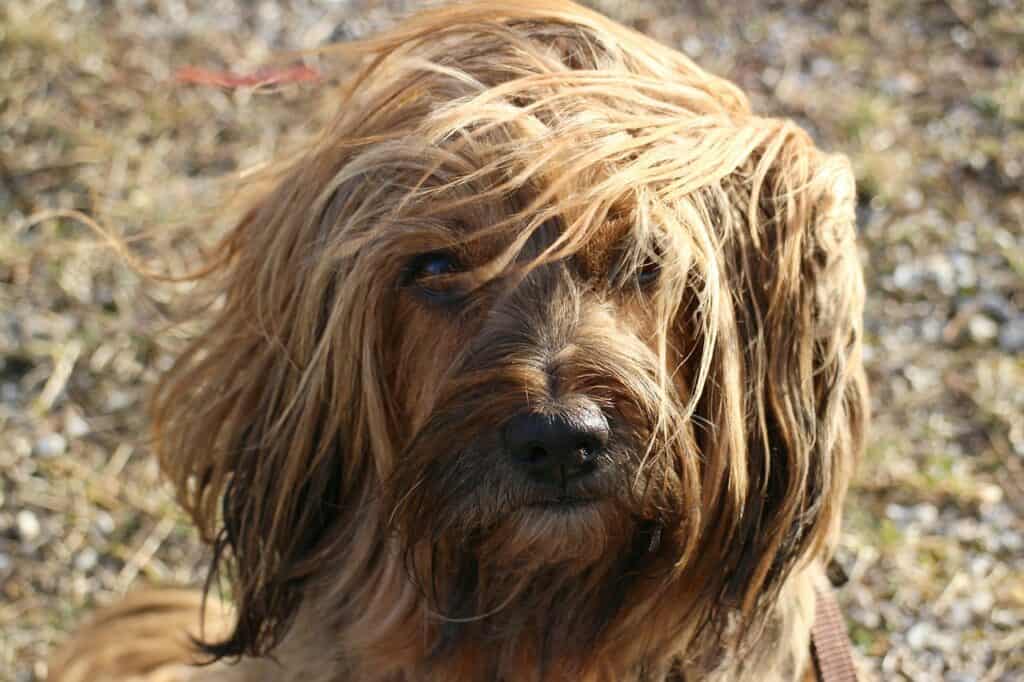The Tibetan Terrier, with its long, flowing coat and friendly disposition, is not actually a true terrier but is often grouped with terrier breeds. Originating from Tibet, this breed was historically kept by Tibetan monks. Known for its intelligence and versatility, the Tibetan Terrier excels as a companion animal and is valued for its loyalty and adaptability. With a dignified presence and a gentle spirit, this breed makes a wonderful addition to households seeking a loving and devoted canine companion.

| Category (Explanation) | Breed Information |
|---|---|
| Year of Breed Conception | Ancient |
| Country of Origin | Tibet |
| Weight (lbs & kg) (Male) | 18-30 lbs (8-14 kg) |
| Weight (lbs & kg) (Female) | 18-30 lbs (8-14 kg) |
| Coat Type | Double coat, long and straight |
| Color Variations | Various colors, including white, gold, and tricolor |
| Shedding Level (Low, Moderate, High) | Low to Moderate |
| Height (cm & in) | 14-16 inches (36-41 cm) |
| Breed Size | Medium |
| Trainability (Low, Moderate, High) | Moderate |
| Mental Needs (Low, Moderate, High) | Moderate |
| Intelligence Level (Low, Moderate, High) | High |
| Energy Level (Low, Moderate, High) | Moderate |
| Agility (Low, Moderate, High) | Moderate |
| Loyalty (Low, Moderate, High) | High |
| Playfulness (Low, Moderate, High) | Moderate |
| Exercise Needs | Regular exercise and playtime |
| Guarding Proficiency (Low, Moderate, High) | Moderate |
| Sociability with Children (Low, Moderate, High) | High |
| Barking Level (Low, Moderate, High) | Moderate |
| Digging Tendency (Low, Moderate, High) | Low |
| Destructive Behavior (Low, Moderate, High) | Low |
| Drooling Level (Low, Moderate, High) | Low |
| Obedience Level (Low, Moderate, High) | Moderate |
| Apartment Friendly (Yes/No) | Yes, with sufficient exercise |
| Inherent Prey Drive | Low to Moderate |
| Physical Risk to Others (Low, Moderate, High) | Low |
| Travel Fatality Risk (Low, Moderate, High) | Low |
| Allergen Potential | Low |
| Health Concerns (List of Common Health Concerns) | Hip Dysplasia, Progressive Retinal Atrophy |
| Average Life Expectancy (Life Expectancy in Years) | 12-15 years |
Woof Mastery is reader supported and our articles may contain affiliate links.
Instead of running third party ads that we have no control of we only use links from high-quality companies we are directly partnered with. Making use of these links come at no cost to you our reader, and in many cases have the extra benefit of discounted rates or sign up bonuses.
If you’re interested you can read more about our affiliate policy here.
We appreciate your support and always insure that the products and services we recommend are high-quality, helpful and relevant to the subject at hand!
The Tibetan Terrier, despite its name, is not a true terrier but is often grouped with terrier breeds. Originating from Tibet, this breed has a rich history dating back centuries. Bred by Tibetan monks, the Tibetan Terrier served as a companion and watchdog in monasteries. Highly regarded for its intelligence and adaptability, this breed symbolizes good luck in Tibetan culture. Over time, the Tibetan Terrier’s unique qualities have made it a cherished companion worldwide, showcasing a history rooted in the Himalayan region and a legacy of companionship and devotion.

The Tibetan Terrier, despite its name, is special for its versatility, intelligence, and gentle nature. Bred by Tibetan monks, this breed served as a companion and watchdog in monasteries. What sets it apart is its ability to adapt to various roles, excelling as a loyal and loving family companion. The Tibetan Terrier’s dignified presence and devotion contribute to its special status as a delightful and devoted canine friend, symbolizing good luck and companionship in Tibetan culture.
The Tibetan Terrier’s traditional role, despite its name, is not that of a true terrier. Originating from Tibet, this breed has a rich history as a companion and watchdog in Tibetan monasteries. Bred by Tibetan monks, it was highly regarded for its intelligence and adaptability. Over time, the Tibetan Terrier transitioned into a beloved family companion, symbolizing good luck in Tibetan culture. Its traditional role continues today as a devoted and affectionate canine friend, bringing companionship and positive energy to households around the world.
Tibetan Terriers are known for their versatility, intelligence, and gentle nature. Bred by Tibetan monks, they served as companions and watchdogs in monasteries. These terriers are characterized by their adaptability and loyalty. Tibetan Terriers transition seamlessly from their historical roles to beloved family companions. They have a dignified presence and a devoted nature, symbolizing good luck and companionship in Tibetan culture. With their gentle disposition and positive energy, they become delightful and devoted canine friends, bringing joy and a sense of calm to households around the world.
Tibetan Terriers are known for their gentle and loyal temperament. Bred as companions and watchdogs in Tibetan monasteries, they possess a dignified and calm nature. With proper training and socialization, they become devoted family members. Tibetan Terriers are typically affectionate and enjoy spending time with their families. They may be reserved with strangers but are generally friendly with proper introductions. Despite their name, they are not true terriers and have a calm disposition. With consistent positive reinforcement, Tibetan Terriers develop into loving and calm family companions, symbolizing good luck and positive energy in households.
Tibetan Terriers are medium-sized dogs with a well-balanced and sturdy build. They have a distinctive head with a moderately long muzzle and a well-defined stop. Their eyes are large, dark, and expressive, and their ears are medium-sized and drop forward. The breed is known for its long, double coat that can be straight or wavy, in various colors, including golden, cream, or tricolor. Tibetan Terriers have a straight back, a high-set tail, and a lively, free-moving gait. They convey a sense of dignity, warmth, and a unique coat texture.
Tibetan Terriers come in various color variations, contributing to their gentle and distinctive appearance. The most common color variations for Tibetan Terriers include:
Tibetan Terriers come in various coat patterns and colors, including golden, cream, or tricolor. While the breed standard does not specifically describe coat patterns, individual Tibetan Terriers can have variations in coat color and markings. The breed’s coat is long, double, and may be straight or wavy. Tibetan Terriers may have distinct markings, and their coat colors should be rich and well-defined, contributing to their unique and charming appearance. Despite their name, Tibetan Terriers are not true terriers and have a calm and gentle disposition.
Tibetan Terriers have a low shedding level. Their long, double coat sheds minimally, and regular grooming is necessary to prevent matting and maintain coat health. Brushing the coat a few times a week helps remove loose fur and prevents tangling. While Tibetan Terriers are not heavy shedders, grooming practices are important for the well-being of their distinctive coat.
Tibetan Terriers have a long, double coat that requires regular grooming to maintain its health and beauty. Here are some grooming habits for Tibetan Terriers:
Tibetan Terriers have a moderate activity level. These medium-sized dogs enjoy regular walks and playtime to meet their exercise needs. While they are not excessively hyperactive, providing mental stimulation through training sessions and interactive toys is important. Tibetan Terriers thrive on companionship and may enjoy engaging in activities with their owners.
Tibetan Terriers are known for their intelligence and unique charm. Their problem-solving skills and adaptability contribute to their versatility. Positive reinforcement in training and activities that engage their minds enhance their overall intelligence. Their gentle and spiritual nature adds a distinctive quality to their intelligent behavior.
Tibetan Terriers require mental stimulation to keep them engaged. Engage them in activities like puzzle toys, interactive games, and training exercises. Regular social interaction is important for their well-being. Obedience training not only provides mental stimulation but also strengthens the bond with their owners. Routine, affection, and a safe environment contribute to their overall mental well-being.
Enter The Woof Mastery

Before bringing a Tibetan Terrier into your home, consider the following:
Tibetan Terriers, being energetic and agile, may pose a risk if not properly trained and socialized. Early socialization and consistent training are crucial to manage their behavior, ensuring they are comfortable around people and other pets. Owners should focus on positive reinforcement techniques to ensure they respond well to commands.
Tibetan Terriers, being energetic and agile, may enjoy playtime with older children. Supervision is important due to their energy levels. Early socialization and consistent training are crucial to ensure they are well-behaved around children. Their friendly nature may make them suitable companions for families with older children.
Tibetan Terriers may have varied responses to water. Some may enjoy swimming, while others may not be as comfortable. As with any dog, introduce them to water gradually and observe their comfort level. Use a canine life vest if swimming in open water or deep pools to ensure their safety.
Remember that Tibetan Terrier puppies, like all puppies, are eager to please and learn. Positive and consistent training practices will help them become well-behaved, obedient, and happy adult dogs. Building a strong and trusting bond with your puppy through training is a rewarding experience for both you and your canine companion.
Tibetan Terriers may bark to alert their owners or express themselves. While they are not known for excessive barking, early training and socialization can help in preventing unwanted barking behaviors. Positive reinforcement methods are effective in shaping their behavior.
Tibetan Terriers thrive in homes with active families who can provide regular exercise and play. They do well in houses with yards but can adapt to apartment living with sufficient activity. Regular grooming is necessary for their coat. Socialization is crucial to prevent shyness or aggression. Positive reinforcement training is effective in shaping their behavior.
Traveling with Tibetan Terriers requires considerations for their size and grooming needs. Use a secure travel crate or restraint for their safety. Plan for breaks during the journey to address their energy levels and provide bathroom breaks. Address any potential anxiety through positive associations with travel and familiar items. Regular grooming is essential, so plan accordingly. Choose airlines with policies accommodating their size if flying, and ensure compliance with crate requirements for air travel safety.
Tibetan Terriers may be prone to specific health concerns. While not all individuals will experience these issues, it’s essential for owners to be aware of potential health problems and work with veterinarians to maintain their pets’ well-being. Common health concerns in Tibetan Terriers include:
Regular veterinary check-ups, a balanced diet, proper exercise, and responsible breeding practices can help mitigate some of these health concerns. It’s crucial for Tibetan Terrier owners to work closely with their veterinarians to monitor their pets’ health and address any issues promptly.
Proper nutrition is crucial for the health and well-being of Tibetan Terriers. Here are some nutritional habits and best practices to consider for this breed:
Breed-Specific Laws (BSL): Tibetan Terriers may be subject to breed-specific laws (BSL) in certain areas. These laws are often enacted at the local or municipal level and can vary widely from one jurisdiction to another.
Types of Restrictions: The specific restrictions imposed on Tibetan Terriers under BSL can include mandatory spaying/neutering, special licensing, liability insurance requirements, muzzling in public, and, in some cases, bans on ownership. The severity of these restrictions depends on local regulations.
Rationale for BSL: BSL is typically implemented based on concerns about public safety and perceived risks associated with specific breeds, often due to incidents involving dog attacks. While Tibetan Terriers are not inherently aggressive, they can be affected by BSL due to their physical resemblance to breeds that are sometimes included in these laws.
Controversy: It’s important to note that BSL is a controversial topic. Critics argue that it unfairly targets breeds rather than addressing individual dog behavior and that responsible ownership and training should be emphasized instead of breed-specific restrictions.
Local Regulations: To determine if there are breed-specific laws or restrictions regarding Tibetan Terriers in your area, you should check with your local animal control or government authorities. Be aware of and comply with any local regulations to ensure that you are in compliance with the law while owning a Tibetan Terrier.
Woof Mastery is reader supported and our articles may contain affiliate links.
Instead of running third party ads that we have no control of we only use links from high-quality companies we are directly partnered with. Making use of these links come at no cost to you our reader, and in many cases have the extra benefit of discounted rates or sign up bonuses.
If you’re interested you can read more about our affiliate policy here.
We appreciate your support and always insure that the products and services we recommend are high-quality, helpful and relevant to the subject at hand!
Myth 1: Tibetan Terriers are Hypoallergenic
Myth 2: They Require Extensive Grooming
Myth 3: Tibetan Terriers are Reserved and Aloof
Myth 4: They are Only Suitable for Experienced Owners
Myth 5: Tibetan Terriers Don’t Need Exercise
Myth 6: They are Difficult to Train
Myth 7: Tibetan Terriers Don’t Get Along with Children
Myth 8: Tibetan Terriers are High-Energy
Myth 9: They are Prone to Health Issues
Myth 10: Tibetan Terriers are Not Good for Allergy Sufferers
Understanding the truth behind these myths helps potential owners make informed decisions about bringing Tibetan Terriers into their homes. With proper care, training, and socialization, Tibetan Terriers can be wonderful companions for various types of owners.
Famous Tibetan Terrier examples are not as widely documented, but these affectionate and adaptable dogs can be found as cherished companions in homes where their calm demeanor is appreciated.
The Tibetan Terrier is culturally significant as a breed with a calm and adaptable nature. Recognized for their long, flowing coat and friendly temperament, Tibetans have become valued as companions. Their historical association with Tibetan monasteries and their appearances in popular media contribute to their cultural recognition. Tibetan Terriers are symbols of serenity and companionship, finding a place in the hearts of dog enthusiasts who appreciate their gentle and amiable qualities.
Notable historical owners of Tibetan Terriers are not widely recorded, but these calm and adaptable dogs have been associated with Tibetan monasteries. Their long, flowing coats and friendly temperament have made them cherished companions, although specific historical figures may not be as prominently featured.
Tibetan Terriers, like many dog breeds, have faced specific challenges. Some notable challenges include:
The Tibetan Terrier is a breed that originated in Tibet and was developed as a companion and working dog. It is believed to have been created through the combination of several breeds, including:
Tibetan Terriers, with their unique charm and affectionate nature, make wonderful additions to any household. Known for their adaptability and friendly disposition, they make excellent family companions. Their versatility allows them to thrive in various living conditions, bringing joy to urban and suburban households alike. Engaging in activities that cater to their need for exercise and interaction enhances their well-being and strengthens the bond they share with their families. With their distinctive appearance and spirited personality, Tibetan Terriers become cherished members of the home, offering both companionship and joy.